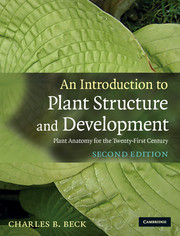Book contents
- Frontmatter
- Contents
- Preface to the second edition
- Preface
- Acknowledgements
- General references
- Chapter 1 Problems of adaptation to a terrestrial environment
- Chapter 2 An overview of plant structure and development
- Chapter 3 The protoplast of the eukaryotic cell
- Chapter 4 Structure and development of the cell wall
- Chapter 5 Meristems of the shoot and their role in plant growth and development
- Chapter 6 Morphology and development of the primary vascular system of the stem
- Chapter 7 Sympodial systems and patterns of nodal anatomy
- Chapter 8 The epidermis
- Chapter 9 The origin of secondary tissue systems and the effect of their formation on the primary body in seed plants
- Chapter 10 The vascular cambium: structure and function
- Chapter 11 Secondary xylem
- Chapter 12 The phloem
- Chapter 13 Periderm, rhytidome, and the nature of bark
- Chapter 14 Unusual features of structure and development in stems and roots
- Chapter 15 Secretion in plants
- Chapter 16 The root
- Chapter 17 The leaf
- Chapter 18 Reproduction and the origin of the sporophyte
- Glossary
- Index
- References
Chapter 2 - An overview of plant structure and development
Published online by Cambridge University Press: 05 June 2012
- Frontmatter
- Contents
- Preface to the second edition
- Preface
- Acknowledgements
- General references
- Chapter 1 Problems of adaptation to a terrestrial environment
- Chapter 2 An overview of plant structure and development
- Chapter 3 The protoplast of the eukaryotic cell
- Chapter 4 Structure and development of the cell wall
- Chapter 5 Meristems of the shoot and their role in plant growth and development
- Chapter 6 Morphology and development of the primary vascular system of the stem
- Chapter 7 Sympodial systems and patterns of nodal anatomy
- Chapter 8 The epidermis
- Chapter 9 The origin of secondary tissue systems and the effect of their formation on the primary body in seed plants
- Chapter 10 The vascular cambium: structure and function
- Chapter 11 Secondary xylem
- Chapter 12 The phloem
- Chapter 13 Periderm, rhytidome, and the nature of bark
- Chapter 14 Unusual features of structure and development in stems and roots
- Chapter 15 Secretion in plants
- Chapter 16 The root
- Chapter 17 The leaf
- Chapter 18 Reproduction and the origin of the sporophyte
- Glossary
- Index
- References
Summary
Perspective: origin of multicellularity
Since early in the study of plants botanists have been interested in the structure, function, development, and evolution of cells, tissues, and organs. Because some green plants are very small and unicellular, but others are large and multicellular, the origin of multicellularity in plants also has been of great interest to botanists. Among the green algae from which higher plants are thought to have evolved, some colonial taxa such as Pandorina, Volvox, and relatives consist of aggregations of motile cells that individually appear identical to apparently related unicellular forms (Fig. 2.1). Consequently, it was concluded early in the history of botany, and widely accepted, that multicellular plants evolved by the aggregation of unicellular organisms. This viewpoint led to the establishment of the cell theory of multicellularity in plants which proposes that cells are the building blocks of multicellular plants (Fig. 2.2). As early as 1867, however, Hoffmeister proposed that cells are simply subdivisions within an organism. This viewpoint, supported and expanded upon in 1906 by Lester Sharp at Cornell University, has been elucidated and clarified more recently by Hagemann (1982), Kaplan (1992), and Wojtaszek (2000) among others. These workers conclude on the basis of abundant evidence that a unicellular alga and a large vascular plant are organisms that differ primarily in size and in the degree to which they have been subdivided by cells (Fig. 2.2).
- Type
- Chapter
- Information
- An Introduction to Plant Structure and DevelopmentPlant Anatomy for the Twenty-First Century, pp. 8 - 37Publisher: Cambridge University PressPrint publication year: 2010



